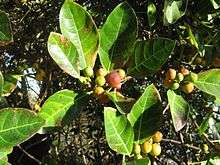Ficus fraseri
Ficus fraseri, the white sandpaper fig or shiny sandpaper fig, is one of several fig species commonly known as sandpaper figs. It is native to New South Wales, Queensland and the Northern Territory in Australia and to New Caledonia and Vanuatu.[3][4] Other common names are "figwood" and "watery fig".[1][5]
| Ficus fraseri | |
|---|---|
 | |
| Scientific classification | |
| Kingdom: | |
| (unranked): | |
| (unranked): | |
| (unranked): | |
| Order: | |
| Family: | |
| Genus: | |
| Species: | F. fraseri |
| Binomial name | |
| Ficus fraseri | |
| Synonyms | |
| |
It grows as either a shrub or tree with height ranging from around 6 to 15 metres.[6][7] Its leaves are 6 to 14 cm long and 2.5 to 6.5 cm wide on petioles that are 1 to 2 cm long.[6] The rounded figs are 1 to 1.5 cm long and start out yellow in colour, maturing to orange-red between May and February in the species' native range.[6] They are edible, but insipid.[8]
In Australia, the species occurs from Tuggerah Lake in New South Wales, northwards to the Atherton Tableland in Queensland,[6][7] and rarely in the Northern Territory.[4]
The grey-headed flying fox feeds on the figs.[9]
Although rarely seen in cultivation, it is a fast-growing, ornamental species.[7] It can be easily propagated from seed.[7]
Distribution
Chew[4] states that F. fraseri is found in the Northern Territory, a statement repeated by Govaerts et. al.[3]. However, Harden (1990)[6] gives New South Wales and Queensland as the only Australian states where it is found. Botanists in Australia seem in little doubt about where it is found when the Australasian Virtual Herbarium data are consulted, giving a distribution map.[10] GBIF, unlike the Australian Plant Name Index and Plants of the World online, states that Ficus fraseri is a synonym of Ficus virens Aiton. However, Australian botanists clearly distinguish the two species. (See the occurrence map for F. virens.[11])
Taxonomy
It was first described by Miquel in 1848.[2]
References
| Wikimedia Commons has media related to Ficus fraseri. |
- "Ficus fraseri". Australian Plant Name Index (APNI), IBIS database. Centre for Plant Biodiversity Research, Australian Government.
- Miquel, F.A.W. in Hooker, W.J. 1848. "Prodromus Monographiae Ficuum. London Journal of Botany 7: 235". Retrieved 21 May 2018.
- Govaerts, R. et. al. 2018. "Plants of the World online: Ficus fraseri". Board of Trustees of the Royal Botanic Gardens, Kew. Retrieved 21 May 2018.
- Chew, W.-L. 1989. "Flora of Australia online: Ficus fraseri'". Data derived from Flora of Australia volume 3, ABRS, ©Commonwealth of Australia. Retrieved 21 May 2018.
- "Ficus fraseri". Endémía – Faune & Flore de Nouvelle-Calédonie. Archived from the original on 16 July 2011. Retrieved 12 July 2008.
- "Ficus fraseri Miq". PlantNET – New South Wales Flora Online. Royal Botanic Gardens & Domain Trust, Sydney Australia. Retrieved 10 July 2008. }
- Nicholson, Nan & Hugh (1985). Australian Rainforest Plants. New South Wales: Terania Rainforest Nursery. ISBN 0958943605.
- Low, T. (1991). Wild Food Plants Of Australia. Australia: Angus & Robertson. ISBN 0207169306.
- "Diet list for Grey-headed Flying-fox Pteropus poliocephalus '" (PDF). Australasian Bat Society Inc. July 2001. Archived from the original (PDF) on 31 August 2007. Retrieved 12 July 2008.
- "AVH occurrence map: Ficus fraseri'". Retrieved 21 May 2018.
- "AVH occurrence map: Ficus virens'". Retrieved 21 May 2018.